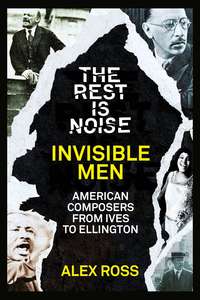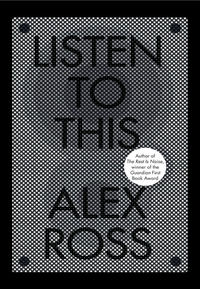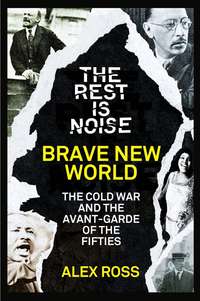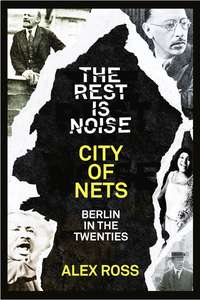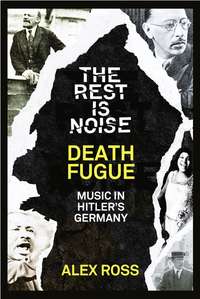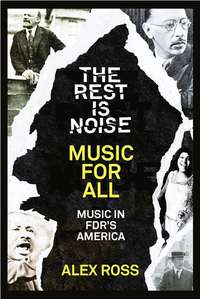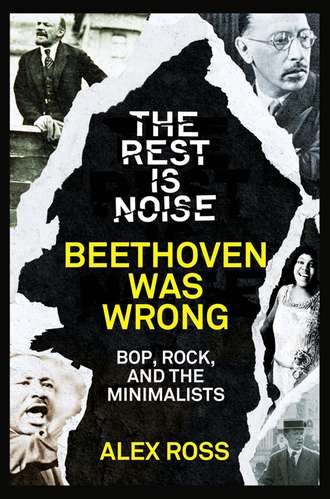
Полная версия
The Rest Is Noise Series: Beethoven Was Wrong: Bop, Rock, and the Minimalists

This is a chapter from Alex Ross’s groundbreaking history of 20th century classical music, The Rest is Noise.
It is released as a special stand-alone ebook to celebrate a year-long festival at the Southbank Centre, inspired by the book. The festival consists of a series of themed concerts. Read this chapter if you’re attending concerts in the episodes
Politics and Spirituality in the Late Twentieth Century and Superpower! Hollywood, Minimalism and Experiments in Sound
Alex Ross, music critic for the New Yorker, is the recipient of numerous awards for his work, including an Arts and Letters Award from the American Academy of Arts and Letters, the Belmont Prize in Germany and a MacArthur Fellowship. The Rest is Noise was his first book and garnered huge critical acclaim and a number of awards, including the Guardian First Book Award and the National Book Critics Circle Award. He is also the author of Listen to This.
BEETHOVEN WAS WRONG
Bop, Rock, and the Minimalists
From The Rest Is Noise by Alex Ross

Contents
Beethoven Was Wrong
Notes
Suggested Listening and Reading
Copyright
About the Publisher
14
BEETHOVEN WAS WRONG
Bop, Rock, and the Minimalists
One night in 1967, György Ligeti was sitting with several colleagues at the Darmstadt Schlosskeller, the favorite late-night hangout of teachers and students at the Summer Courses for New Music, when Sgt. Pepper’s Lonely Hearts Club Band, a new album by the Beatles, started playing over the loudspeakers. Some of the sounds on the record bore a surprising resemblance to the Darmstadters’ latest and most advanced experiments. The song “A Day in the Life” included two spells of ad libitum playing, the second of them leading into a gorgeously strange E-major chord played by three pianos and a harmonium. Players were given a score indicating what register they should have reached in any given bar. The last chord was executed in musique concrète fashion, the attack cut off and the decay amplified over a long duration.
The Beatles had first dipped into the Darmstadt sound in March of the previous year, while working on the album Revolver. Paul McCartney had been checking out Stockhausen’s Gesang der Jünglinge, with its electronic layering of voices, and Kontakte, with its swirling tape-loop patterns. At his request, engineers at Abbey Road Studios inserted similar effects into the song “Tomorrow Never Knows.” By way of thanks, the Beatles put Stockhausen’s face on the cover of Sgt. Pepper’s Lonely Hearts Club Band, in and among cutout pictures of other mavericks and countercultural heroes. The following year, for the White Album, John Lennon and Yoko Ono created the tape collage “Revolution 9,” where, for a split second, the final chords of Sibelius’s Seventh Symphony can be heard. Adventurous rock bands on the West Coast also paid heed to the classical avant-garde. Members of both the Grateful Dead and Jefferson Airplane attended Stockhausen’s lectures in Los Angeles in 1966 and 1967, while the maverick rock star Frank Zappa spoke of his teenage love for the music of Edgard Varèse, whom he once looked up in the phone book and called out of the blue.
Even the most jaded veteran of twentieth-century musical upheaval must have been startled to find that the postwar avant-garde was now serving as mood music for the psychedelic generation. The wall separating classical music from neighboring genres appeared ready to crumble, as it had momentarily in the twenties and thirties, when Copland, Gershwin, and Ellington crossed paths at Carnegie Hall. Classical record labels made amusing attempts to capitalize on the phenomenon by marketing abstruse modern repertory to kids on LSD. An LP of Bengt Hambraeus’s Constellations II and Interferences on the Limelight label carried this text on the jacket: “Listening to Bengt Hambraeus’s fantastic sound—it’s [sic] magnificent electronic and organ-organized electronic total sound experience should involve you as much as any music that you are capable of loving … be it the sound of The Beatles, Bach, Beethoven, Boulez, Beach Boys, or Belefonte [sic], Barbra Streisand, Pearl Bailey, Blue Cheer, or whatever. Hambraeus is really tuned in. Smashing!”
Even as Stockhausen and Ligeti brushed against the counterculture, several younger Americans—Terry Riley, Steve Reich, and Philip Glass—made a different kind of breakthrough. They simplified their harmonic language and rediscovered the pleasure of a steady pulse, devising a modern tonality that had nothing nostalgic about it. What Weill said in the twenties held true again: “Once musicians obtained everything they had imagined in their most daring dreams, they started again from scratch.”
Riley, Reich, and Glass came to be called minimalists, although they are better understood as the continuation of a circuitous, difficult-to-name development in American music that dated back to the early years of the century, and more often than not took root on the West Coast. This alternative canon includes Henry Cowell and Lou Harrison, who drew on non-Western traditions and built up a hypnotic atmosphere through insistent repetition; Morton Feldman, who distributed minimal parcels of sound over long durations; and La Monte Young, who made music from long, buzzing drones. All of them in one way or another set aside a premise that had governed classical composition for centuries—the conception of a musical work as a self-contained linguistic activity that develops relationships among discrete thematic characters over a well-marked period of time. This music was, by contrast, open-ended, potentially limitless.
It was a purely American art, free of modernist anxiety and inflected with pop optimism. Reich said: “Schoenberg gives a very honest musical portrayal of his times. I salute him—but I don’t want to write like him. Stockhausen, Berio, and Boulez were portraying in very honest terms what it was like to pick up the pieces of a bombed-out continent after World War II. But for some American in 1948 or 1958 or 1968—in the real context of tail fins, Chuck Berry, and millions of burgers sold—to pretend that instead we’re really going to have the dark-brown Angst of Vienna is a lie, a musical lie …” Reich and his colleagues borrowed from popular music, especially from bebop and modern jazz, and they affected pop music in turn. The Velvet Underground adopted Young’s drone aesthetic. Art rockers such as David Bowie and Brian Eno showed up at Reich’s and Glass’s shows. Minimalist influence radiated outward in the eighties and nineties, to the point where you could walk into any hip boutique or hotel lounge and sooner or later hear some distant, burbling cousin of Reich’s Music for 18 Musicians.
Eno once summarized minimalism as “a drift away from narrative and towards landscape, from performed event to sonic space.” Riley, Reich, and Glass spent their formative years in the urban wilds of New York and San Francisco, but their works have spiritual links to the capacious West. Unlike Copland’s sepia-toned prairie, minimalist vistas are filtered through new ways of seeing and hearing that relate to the technology of speed. They evoke the experience of driving in a car across empty desert, the layered repetitions in the music mirroring the changes that the eye perceives—road signs flashing by, a mountain range shifting on the horizon, a pedal point of asphalt underneath.
Bebop
During the two-decade stretch from 1945 to 1965, when the minimalist composers were growing from childhood to maturity, American popular music exploded with creative energy. Jazz, blues, country, and gospel evolved into rhythm and blues, rock ’n’ roll, soul, and funk. Hank Williams, a white singer with an ear for the blues, crafted country songs of gem-like beauty; Ray Charles and James Brown fused gospel elation with blues sensuality; Chuck Berry let loose the stripped-down anarchy of rock ’n’ roll; Elvis Presley and the Beatles repackaged rock for a huge youth public.
For young American composers with open ears, the Cold War decades were, above all, the age of bebop and modern jazz. Dizzy Gillespie, Charlie Parker, Thelonious Monk, Miles Davis, John Coltrane, and Charles Mingus burst through the formal confines of swing and made music of ricocheting freedom and imperturbable cool. At the height of bop, electric strings of notes lashed around like downed power lines on wet pavement. Two sounds caught the ear of the fourteen-year-old Steve Reich: the punch-drunk rhythm of The Rite of Spring and the blindsiding beat of Kenny Clarke. Terry Riley was a bebop kid who later mastered ragtime piano. La Monte Young played excellent alto sax in his youth and probably could have had a major jazz career if he had wanted one. (When Young auditioned for a place in the top-notch Los Angeles City College jazz band, he beat out Eric Dolphy.) Philip Glass never played jazz, but listened avidly. The history of minimalism can’t be written without a cursory look at postwar jazz.
It was at the end of the Second World War that many young jazz players began to think of themselves as “serious musicians,” to quote Amiri Baraka’s classic book Blues People. Bebop, the poet said, articulated the self-esteem felt by hundreds of thousands of black soldiers as they returned home from the Second World War. When Parker inserted the opening notes of The Rite of Spring into “Salt Peanuts,” he was paying his respects while also declaring his freedom with a somewhat impudent air. You couldn’t dance to “Koko”; you had to sit back and listen as Parker scribbled lightning in the air. Monk threw in angular lines and dissonant chords, softening them with the elegance of his touch. Coltrane relished Bartók’s chords of fourths in the Concerto for Orchestra. “We had some fundamental background training in European harmony and music theory superimposed on our own knowledge from Afro-American musical tradition,” Gillespie wrote. “We invented our own way of getting from one place to the next.”
Ellington, in the twenties, had capitalized on the timbral possibilities of electrical recording. Bebop players took advantage of the next big advance, the long-playing record. The LP side allowed for the creation of half-composed, half-improvised works of mesmerizing breadth, the logical descendants of Black, Brown and Beige. In March 1959, Miles Davis released Kind of Blue, which put the brakes on bop’s forward drive. “So What,” the nine-minute opening track, is a proto-minimalist piece, defined by the dreamlike slowness of the harmonic rhythm. As the melodies drift by and change color, the underlying harmony stays fixed on a D-minor seventh chord, with periodic sidesteps into E-flat minor. Mingus, Coltrane, and Ornette Coleman also abandoned standard progressions in favor of a more open-ended tonal language. Their writing had much in common with the expanded tonality of Debussy, Stravinsky, and Messiaen. When Mingus explicated his “pedal point” style in the notes to his 1963 album The Black Saint and the Sinner Lady, he could have been paraphrasing Messiaen’s Technique of My Musical Language, with its schemes of multiple modes.
Jazz had entered its high-modern era, and assumed a modernist contempt for convention. Monk set the tone: “You play what you want, and let the public pick up what you are doing—even if it does take them fifteen, twenty years.” Miles Davis, in performance, turned his back to the crowd in Schoenbergian fashion. Bebop and dissonant composition drew close enough that there was talk of a merger. In the early sixties the composer and scholar Gunther Schuller propagated the idea of “Third Stream,” a confluence of jazz and classical energies. “It is a way of making music,” Schuller later wrote, “which holds that all musics are created equal, coexisting in a beautiful brother-hood/sisterhood of musics that complement and fructify each other.” Schuller brought in the likes of Coleman and Eric Dolphy to perform his brawny twelve-tone compositions, while Coleman asked Schuller for advice, notably while planning his epoch-making 1960 album Free Jazz. Anthony Braxton and Cecil Taylor, two other pioneers of free jazz, sounded like atonal composers in exile.
Even in its arcane phase, modern jazz hung on to its dynamism, its physical energy. That spirit proved irresistible to younger classical composers looking for a way out of Schoenberg’s maze. Jazz was intuitive, intimate, collaborative; it was serious in thought but playful in execution. Steve Reich remembers attending composition classes where students showed off byzantine scores whose intellectual underpinnings could be discussed ad nauseam. Then he’d go to see Coltrane play with his quartet. He liked the idea that Coltrane could walk out with a saxophone, play freewheeling improvisations on just one or two harmonies, and then disappear into the night. “The music just comes out,” Reich later said. “There’s no argument. There it is. This presented me with a human choice, almost an ethical, moral choice.”
The California Avant-Garde
Reich was living in northern California when he had his Coltrane revelation. A few years later, he created It’s Gonna Rain, the first example of what he would call “music as a gradual process.” Maybe this New York–born composer would have found his way even if he had never left the East Coast, but his move westward brought him into contact with alternative American traditions that had been developing in relative isolation since the second decade of the century, with sporadic infusions from the European émigrés who had come to Los Angeles in the thirties and forties. In fact, the circuitous chain of events that led to minimalism began with a kind of California mutation of the Second Viennese School.
The story begins, oddly and aptly, with Charles Seeger, the future dogmatician of American Popular Front music, who came out to the University of California at Berkeley in 1912 to start a music department. The idea of teaching music in a university was novel enough that Seeger’s work fell under the purview of the Department of Agriculture. He held classes in a YMCA, in the Hearst Mining Building, and in a “smelly old house” on Bancroft Way. With no curriculum in place, Seeger felt free to introduce unorthodox ideas. He presented his theory of “dissonant counterpoint,” with its anticipations of twelve-tone practice, and also exposed students to early music, folk music, popular music, and non-Western traditions.
The first student to receive a thorough grounding in Seeger’s syllabus went on to become the godfather of the American experimental tradition. Henry Cowell was the son of a bohemian Irish poet who settled in San Francisco and hailed it as “an undefiled Eden.” Young Henry attracted attention as a child prodigy and gave solo recitals of his piano compositions. One precocious teenage piece, Adventures in Harmony, included a flurry of cluster chords, dissonances produced by hitting groups of adjacent keys with the entire hand. Other pieces reduced music to a few essentials: for example, in The Anaemic Rag chains of thirds unwind over an open-fifth ostinato.
Cowell enrolled at the University of California in 1914 and studied with Seeger for two crucial years. He also joined a mildly cultish Pismo Beach community called Temple of the People, led by the Theosophist poet John Varian, who proclaimed, “There is a new race birthing here in the West. We are the germic embryonic seed of future majesties of growth.” From Varian and other local visionaries Cowell inherited the idea that California would be the eastern frontier of a great Pacific Rim culture, an ecstatic commingling of far-flung peoples. His vision of a Pacific Rim utopia grew to embrace the entire globe. Indian music, Japanese koto and shakuhachi, Balinese gamelan, old American hymns, Gaelic airs, and Icelandic rímur all figured in his music at one time or another. He thought nothing of supplementing a string quintet with three Native American thundersticks.
In 1930, Cowell summed up his and Seeger’s ideas in an astonishing little book titled New Musical Resources, a kind of American Harmonielehre, which anticipated many “big ideas” of the postwar avant-garde. One central concept of the book was that harmony and rhythm should be interdependent; since any resonating tone consists of a certain number of vibrations per second, the ratios among the notes in any given chord could be used to dictate the rhythms of any given bar. For example, a chord of G, C, and E would translate into simultaneous pulses of three against four against five. Back in 1917 and 1919, Cowell put these ideas into practice in his Quartet Romantic and Quartet Euphometric, although he acknowledged that the pieces were (at that time) unplayable.
On one page of New Musical Resources Cowell proposed in passing that “highly engrossing rhythmical complexes” could be punched out on the paper roll of a player piano. Conlon Nancarrow, an Arkansas-born composer of radical tendencies who had fought for the Communists during the Spanish Civil War and then gone into Mexican exile, saw a world of possibility in Cowell’s suggestion, and relied on his mechanical instrument to execute insanely intricate rhythmic designs that only a many-armed robot pianist could have played. In the notorious Study No. 33, for example, tempos are superimposed according to the ratio √__2/2. This music was maximal rather than minimal, but its jazzy, hyperkinetic energy put it far outside the postwar modernist mainstream.
Harry Partch, the other great West Coast nonconformist of the twenties and thirties, wanted to “find a way outside”—to jettison the entire discourse of European music as it had been practiced since at least the time of Bach.
Partch was a true child of the Wild West. He spent much of his childhood in the railway outpost of Benson, Arizona, where his father was a government inspector. According to Bob Gilmore’s biography, young Harry caught glimpses of old-school outlaws on the edge of town. Moving to Los Angeles in 1919, Partch studied at the University of Southern California and made money as a movie-house pianist. Stylish, handsome, and gay—homosexuality is a common thread among composers of this time and place—Partch fell in love with a struggling actor named Ramón Samaniego, whom he met when both men were ushers at the Los Angeles Philharmonic. Samaniego ended the affair shortly after changing his name to Ramon Novarro and finding world fame as a silent-movie idol. That experience apparently cemented Partch’s determination to reject the mainstream in favor of the companionship of outcasts.
One day Partch asked himself why there are twelve notes in an octave, and couldn’t find a satisfactory answer. He buried himself in a study of the history of tuning, paying particular attention to Helmholtz’s On the Sensations of Tone. He emerged with the conviction that the modern Western system of equal-tempered tuning had to go. In its place, Partch would revive the tuning principles of the ancient Greeks, who, at least in theory, derived all musical pitches from the clean integer ratios of the natural harmonic series.
To this end, Partch invented a scale made up not of twelve notes but of forty-three. Extant instruments were incapable of producing such microtonal shadings, so Partch invented his own; he started by building an Adapted Viola and eventually fashioned an entire private orchestra of bowed, plucked, and keyboard instruments, together with Cloud-Chamber Bowls (Pyrex carboys obtained from the Berkeley Radiation Laboratory), the Kithara (modeled on a harp-like instrument seen on Greek vases), and the awesome Marimba Eroica (whose lowest notes boom forth from five-foot-high blocks). By the same token, Partch rejected modern styles of singing, which he considered artificial. Like Leoš Janáček, he sought to close the gap between song and speech, and his annotations of overheard American conversations bear a striking resemblance to Janáček’s transcriptions of Czech. A Western tradition clotted with studied abstractions—what Partch called the “Faustian” strain—would give way to “corporeal music,” an art at one with the body and the soul.
On a trip to Europe in the early thirties, Partch aroused the interest of William Butler Yeats, who watched as the young American composer chanted Psalm 137, “By the Rivers of Babylon,” while sawing on the Adapted Viola. Yeats was charmed, but the musical establishments of Europe and America ignored or mocked Partch’s ideas. By the time he returned to America in 1935, the Great Depression was at its height, and prospects for a conventional career seemed poor.
Partch now made a momentous decision: instead of begging for assistance from patrons or the WPA bureaucracy, he dropped out of civilization entirely, and became a hobo. For several years he crisscrossed the country, riding trains, doing manual labor, sleeping in shelters or in the wild, contracting syphilis, working occasionally as a proofreader, and, all the while, rethinking every parameter of music. In the desert city of Barstow, California, he found a set of inscriptions on a highway railing, which he wrote down for future use. An excerpt:
Car just passed by,
Make that two more, three more.
Do not think they’ll let me finish my story.
Here she comes, a truck, not a fuck, but a truck. Just a truck.
Hoping to get the hell out, here’s my name—
Johnnie Reinwald, nine-fifteen South Westlake Avenue, Los Angeles
These words reappeared in the 1941 cycle Barstow, for baritone and Adapted Guitar. The landscape is nothing like Copland’s idealized heartland, where the wheat is plentiful and golden. Partch’s songs captured the roughness of life during the Great Depression—you can practically smell rye on the breath of the singer. A lot of people would be hard-pressed to identify Barstow as “classical music” at all. It comes closer to the twisted white blues of Frank Zappa, Captain Beefheart, and Tom Waits. The tenuous situation of classical music in America was, for this composer, not a deficit but an advantage. In one essay he wrote: “There is, thank God, a large segment of our population that never heard of J. S. Bach.”
Harry Partch passed through the University of Southern California a few years too early to meet Arnold Schoenberg. This was probably just as well, because the grand old man of modern music would almost certainly have taken a dim view of Partch’s crusade against equal-temperament tuning. In general, Schoenberg was poorly equipped to comprehend the emergent West Coast aesthetic. For him, the ultimate sin was to repeat an idea unnecessarily (“Hi-yo, Silver!”), whereas the California composers were discovering the joys of insistent repetition and gradual change. Yet Schoenberg became an unlikely mentor for two other major figures of the California avant-garde: Lou Harrison and John Cage.
Harrison, a gentle soul in a century of sacred monsters, was born in 1917, the son of a West Coast Chrysler salesman. His mentors were a formidable group: he studied first with Cowell in San Francisco and then with Schoenberg in Los Angeles, and, during a generally unhappy New York period, he worked closely with Charles Ives and Carl Ruggles. From the ultra-moderns, Harrison acquired a flair for stark, prophetic utterances—questing rivers of chant, machinelike ostinatos, erupting dissonances, enveloping silences. From Cowell he picked up a lifelong love of non-Western traditions, especially the Javanese gamelan. And a reading of Partch’s Genesis of a Music in 1949 sparked an interest in just intonation, as pure-ratio tuning is known.




